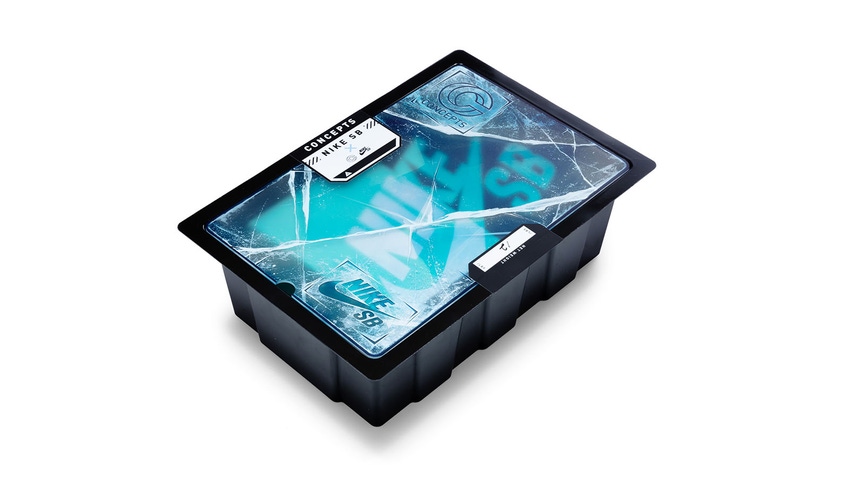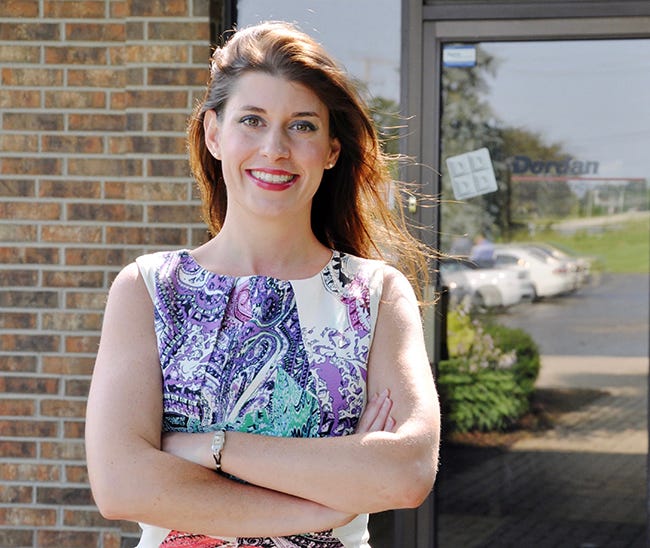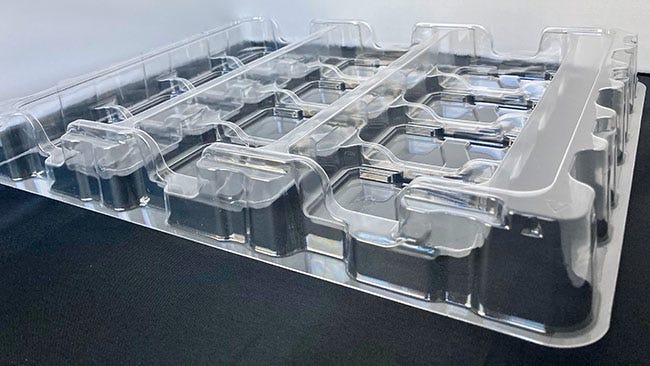Thermoforming — The Surprising Vitality of a Mature Plastics Processing Technology
Thermoforming is well-established as a plastics manufacturing process, but it still tends to be underappreciated or misunderstood. Let’s try to fix that.
December 5, 2023

At a Glance
- Thermoform tooling has become more sophisticated, but costs roughly a quarter of injection mold tooling
- Advances in resins, sheet, and tooling are enabling the use of thermoforming in new applications
- Reshoring has increased demand for domestically produced thermoformed plastic trays used for automated assembly, says Dordan
Advances in materials, tooling, and technology continue to blur the line between the most suitable process and a given application. Thermoforming, of course, can be used to make everything from lightweight, thin-wall packaging to heavy-gauge panels and parts for a range of industries, including automotive, agriculture, construction, medical, and aerospace.
A thermoforming primer
First, some basics: The process takes the form of either vacuum or pressure forming. In the former, a heated, pliable plastic sheet is pulled against the contours of the mold by vacuum pressure. “Since pressure is only applied to one side of the sheet,” explains Formed Plastics Inc., “vacuum forming is typically selected for parts that are relatively simple in design and that do not require deep texture.”
In pressure forming, meanwhile, they note, additional air pressure is used to push the plastic sheet against the mold, not unlike in blow molding. “The combined pressure on both sides of the sheet produces a rich, molded-in texture and allows for complex part geometry that cannot be replicated by vacuum forming. If your part requirements involve undercuts, tight radii, or especially sharp texture, then pressure forming is typically the right choice.”
The process benefits from relatively low tooling costs, as well as from the ability to economically deliver low-volume production runs. Many materials are ripe for thermoforming, including ABS, acrylic, polycarbonate, Kydex-branded acrylic/PVC, and glycol-modified PET (PETG).
Reconsidering pressure forming
Jay Waddell, an industry veteran of more than 40 years who founded Plastic Concepts & Innovations LLC, a heavy/cut sheet thermoforming consultancy, in 1999, says, “I think some people now are underestimating pressure forming. It is moving into injection molding markets where shorter runs are desired.” The process offers a lot of design freedom, and Waddell says he sees many more firms now doing pressure forming, up from just a handful 15 to 20 years ago.
Since heavy-gauge forming creates large parts that are costly to ship, the companies serving these markets tend to be more regional in nature. They usually serve local customers, sometimes with production runs of just 500 to 10,000 parts. Heavy-gauge tends to compete primarily with processes such as rotational molding, structural foam, and metal forming.
Advances in thermoform tooling
Thermoform tooling, meanwhile, has become more sophisticated, Waddell notes. At a cost of roughly 25% that of injection mold tooling, it can offer a huge economic benefit, which is vital for short-run jobs. “Medical plastics has become a big market” for heavy-gauge, he says, for producing such things as monitor covers and equipment panels. Makers of recreational vehicles and boats, as well as agricultural and construction equipment, like the durability and light weight of plastic panels vs. metal, allowing heavy-gauge thermoforming to make major inroads into those sectors.
One significant development on the mold-making side for heavy-gauge has been pioneered by Catalysis Additive Tooling of Westerville, OH. Founded by Darrell Stafford and Rick Shibko, both former Honda of America Mfg. automotive engineers, Catalysis has developed proprietary materials that allow their 3D-printed tools for parts to last thousands of cycles, as highlighted in the video below. These types of tools are used primarily for running polyethylenes and thermoplastic polyolefins (TPOs) that don’t need to be temperature-controlled, noted Waddell.
3D printing — friend or foe?
Some heavy-gauge thermoformers are suspicious of 3D printing and see it as a threat for short-run jobs. But Waddell doesn't see it that way. He believes the two complement one another. “I’d think that a heavy-gauge thermoformer might want to look at getting some 3D printers so they could knock out prototypes quickly and make changes fairly rapidly vs. having to go back and retool and redo this and that — and then go into production.”
Conor Carlin, Boston-based managing director of German machinery maker Illig North America, says that while the actual thermoforming process hasn’t changed all that much in the past 20-plus years, advances in resins, sheet, and tooling are enabling the use of thermoforming for applications where achieving very lightweight parts with excellent barrier protection also offers economic and environmental benefits.
Machine controls also are getting a lot smarter as they adapt to Industry 4.0 protocols, says Carlin, who is also an SPE board member and president-elect for the association.
Making hybrid food containers with rPET
Illig Maschinenbau GmbH & Co. KG — which, for years, has advanced in-mold labeling for thermoforming (IML-T) — has worked for the past two years with PFF Group to supply the UK packaging producer with processing machinery to allow it to make a new food-grade packaging concept. Dubbed IMPAC-T, the system enables the production of recycled PET (rPET) hybrid pots with a card wrap in a single process.

In-mold labeling for thermoforming (IML-T) is helping to enable the increased use of recycled PET vs. polypropylene in food container applications. Image courtesy of Illig Maschinenbau GmbH & Co. KG.
“Using rPET gives industries like dairy an opportunity to switch from traditional polypropylene to circular economy packaging,” says PFF.
Alston Dairy is the first PFF customer to adopt the new IMPAC-T packaging for some of its yogurt products. PFF says the inline manufacturing process uses less energy and enables a higher volume of recycled PET to be incorporated. The process uses at least 50% post-consumer recycled PET with the ability to boost that up to 100%. The card wrap uses up to 100% post-consumer waste; any virgin content is sourced from certified sustainable forest products.
Both the plastic and card can be easily separated by the consumer for onward recycling and the materials can be reprocessed back into packaging. The IMPAC-T process is said to offer a 46% carbon footprint reduction compared to the current assembly system.
Thermoforming benefits for thin-wall packaging
When it comes to rigid, thin-wall packaging generally, thermoforming is the process that enables the thinnest wall thicknesses with high top-load strength values, according to Carlin’s colleague Sven Engelmann. Head of packaging technology at Illig Maschinenbau and a board member of SPE’s European Thermoforming Division, Engelmann added:
Thin packaging walls deliver economic and environmental benefits;
fast processes deliver high output quantities;
mold costs are lower compared to injection molding;
most thermoforming applications require only one mold half.
Steve Zamprelli, vice president of 77-year-old Formed Plastics on New York’s Long Island, added his perspective on some of the advantages of thermoforming:
Typically, it is a low-stress process that enables parts to be produced stronger with fewer concerns of twist or warp.
Faster speed to market, typically with lower tooling costs, allows for changes to be done easily in secondary machining operations.
It offers the ability to change material wall thicknesses and use a variety of materials on the same mold.
Processors usually can produce larger parts with lower costs and in reduced quantities.
And they also can produce parts in lower batch releases.
Dordan: Reduced tooling costs and a boost in productivity
Another packaging thermoformer, Dordan Manufacturing Inc., is a 61-year-old, third-generation, family-owned company based in Woodstock, IL, near Chicago.
Chandler Slavin-Bond, principal and chief marketing officer, notes that thermoforming, through increased mold sizes and faster production, has come to dominate the production of thin-wall products such as drink cups and lids and food containers. “Here,” she says, “the reduction in tooling costs and productivity gains are significant when compared to injection molding.”

Twin-sheet forming is making inroads in the industrial blow molding market, according to Dordan Manufacturing Principal and Chief Marketing Officer Chandler Slavin-Bond.
Additionally, she says, twin-sheet forming — the process of creating hollow plastic parts with double walls or multiple layers — is making inroads in the industrial blow molding market. “Like with injection molding, twin-sheet thermoform tooling is less expensive than blow molding tooling . . . and it allows for the production of more complex shapes.”
Macroeconomic factors have helped to drive growth in another product area, according to Slavin-Bond. As companies continue to reshore their manufacturing operations from China and elsewhere, Dordan is seeing strong growth in demand for the thermoformed plastic trays that assist in automated parts assembly operations. These rigid, thin-wall trays are used to precisely position components on assembly lines.

Rigid, thermoformed trays for use in automated parts assembly operations are among Dordan’s fastest-growing markets. Image courtesy of Dordan Manufacturing Inc.
Additionally, she noted, “We pushed the processing limitations in the production of the thermoformed shoe boxes for Nike’s SB Green Lobster sneaker debut.” Nike markets these shoes to skateboarders and leveraged the lobster theme with a thermoformed box that mimics the totes used on commercial fishing vessels. Nike topped the thermoformed box with a 1/8-inch-thick sheet of acrylic decorated to look like a frozen lake.
Despite these innovations and advances, Waddell says, “Many people don’t know what the capabilities are [of thermoforming]. They don’t know about twin-sheet or pressure forming, or what can be achieved using those processes. They think everything would have to be injection molded.” But as individuals such as Waddell, Carlin, Engelmann, and Slavin-Bond continue to evangelize for the technology and all that it offers, that may begin to change.
Finally, for some more examples of novel and innovative thermoformed parts, check out this PlasticsToday slide show of some of the winners of the SPE Thermoforming Division‘s biennial parts competition. The group presented the awards during its Oct. 23 to 26 conference in Cleveland.
About the Author(s)
You May Also Like




